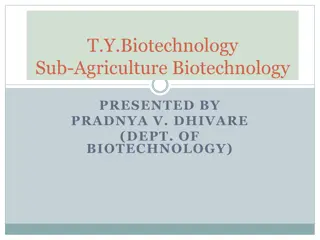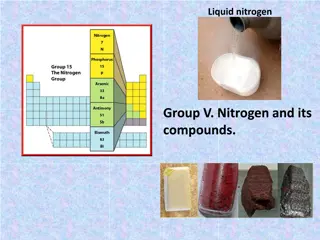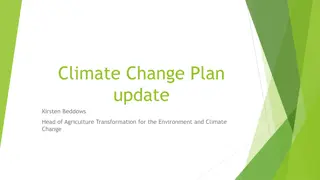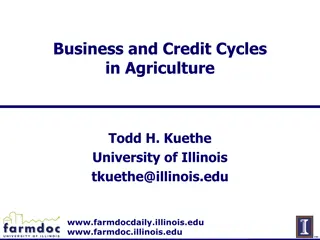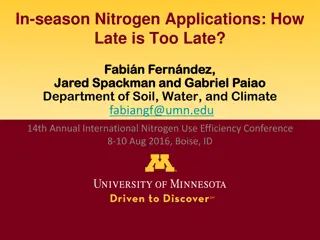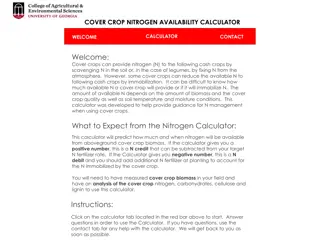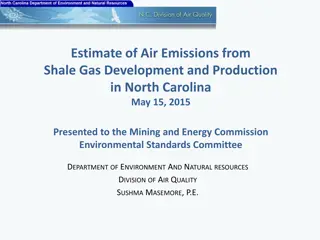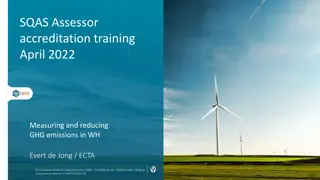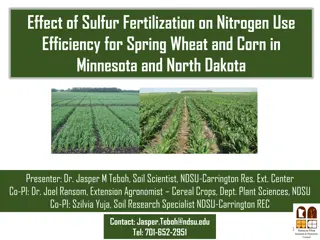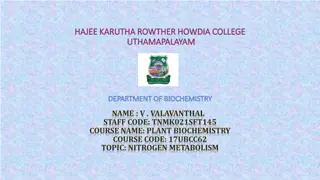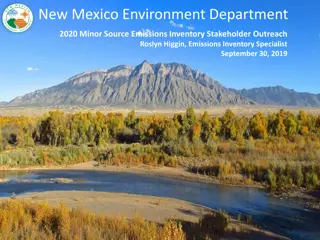Managing Farmland Nitrogen Emissions: Strategies and Research Updates
Soils play a crucial role in greenhouse gas emissions and carbon sequestration. Karl Richards, Head of Soils, Environment & Land-Use Department at Teagasc, discusses the importance of managing farmland nitrogen emissions through various practices. Research focuses on reducing emissions and enhancing carbon sequestration. Projects like MAGGE-PH and MINE show promising results in optimizing soil pH and phosphorus levels to mitigate N2O emissions and enhance carbon sequestration. Practical approaches such as using protected urea and incorporating dung/urine into inventories are highlighted for emission reduction.
Download Presentation

Please find below an Image/Link to download the presentation.
The content on the website is provided AS IS for your information and personal use only. It may not be sold, licensed, or shared on other websites without obtaining consent from the author. Download presentation by click this link. If you encounter any issues during the download, it is possible that the publisher has removed the file from their server.
E N D
Presentation Transcript
Managing farmland nitrogen emissions KARL RICHARDS Head of Soils, Environment & Land-Use Dept., Teagasc, Johnstown Castle. Email: Karl.Richards@Teagasc.ie
Introduction Soils are an important source of greenhouse gas emissions fertiliser, dung/urine, manure Soils can also lock up carbon through sequestration Need to better account for emissions & sequestration Soil management can significantly reduce emissions Research funded by DAFM are focusing on identifying management practices to: Reduce emissions Enhance carbon sequestration Image result for department of agriculture ireland logo 2
Methods Johnstown Castle Image result for department of agriculture ireland logo 3 Teagasc Presentation Footer
Fertiliser Type AGRI-I & Suden projects Protected urea Grassland reduced emissions by more than 70% No difference on tillage soil Protected urea didn t reduce yield Dung and urine low emissions Incorporated into the inventory Emissions reduced Verifiable mitigation measure New LABMACC project Emission factors compound fertiliser & manure IPCC default 1% 50 7500 %N2O reduction compared to CAN 40 7000 Agricultural Soils Emissions 30 Kt CO2 equivalent 6500 IPCC default 596 KT OLD 20 6000 -73% -84% -74% NEW 5500 10 5000 0 1990 1995 2000 10 10 20 2005 2010 18 6 12 2015 27 2.5 5 Urea+NBPT Old Emission Factors New Emission Factors Image result for department of agriculture ireland logo 4 Teagasc Presentation Footer
Optimising Soil pH -38% MAGGE-PH Project Emissions (N2O) decreased with increasing pH (kg N2O-N/ha/yr) Cumulative N2O Emissions reduce by 38% b ab a a Soil pH correlated with soil biology Inventory incorporation NMP online, soil sampling, fertiliser register Grau-Butinyac et al. In Prep urovec et al. 2021. Agriculture, Ecosystems & Environment 311: 107319. Image result for department of agriculture ireland logo 5 Teagasc Presentation Footer
Optimising Soil P MINE Project No carbon N2O emissions very low Optimising soil P reduced emissions Carbon 38% in lab studies C 42% in field studies Effect soil P on microbial community P Effect of soil P on N and C cycling? No Carbon N New ICONICA Project (Soil EJP) Impact of long-term phosphorus additions on Carbon sequestration and Nitrogen Cycling in Agricultural soils Gebremichael et al. 2021. Agronomy 11 (9) p. 17121-13 O'Neill et al. 2020. Soil Biology and Biochemistry 142: 107726. O'Neill et al. 2020. Soil Biology and Biochemistry 142: 107726. O'Neill et al. 2022. Biology and Fertility of Soils doi.org/10.1007/s00374-022-01627-y Image result for department of agriculture ireland logo 6 Teagasc Presentation Footer
Summary Research in Johnstown Castle has: Identified new measures for farmers to reduce emissions Refined the national inventory to make it more accurate Highlighted the effect of soil management on soil biology Investigated the effect of soil biology on emissions & carbon sequestration Image result for department of agriculture ireland logo 7
References Soil Fertility and N2O abatement Gebremichael et al. 2022. Effect of contrasting phosphorus levels on nitrous oxide and carbon dioxide emissions from temperate grassland soils. Scientific Reports, 12 1-13. O Neill et al. 2020. The effect of carbon availability on N2O emissions is moderated by soil phosphorus. Soil Biology and Biochemistry, 142, p.107726. O'Neill et al. 2021. Assessing the impact of long-term soil phosphorus on N-transformation pathways using 15N tracing. Soil Biology and Biochemistry, 152, p.108066. O Neill, et al. 2022. Linking long-term soil phosphorus management to microbial communities involved in nitrogen reactions. Biology and Fertility of Soils, pp.1-14. urovec et al. 2021. Increasing soil pH reduces fertiliser derived N2O emissions in intensively managed temperate grassland. Agriculture, Ecosystems & Environment, 311, 107319. Acknowledgements This research was financially supported under the National Development Plan, Research Stimulus Fund, Department of Agriculture, Food and the Marine (Grant numbers RSF15S655), and under the ERA-GAS ERA-NET 2016 call. FACCE ERA-GAS has received funding from the European Union s Horizon 2020 research and innovation programme under grant agreement No 696356 Image result for department of agriculture ireland logo 8 Teagasc Presentation Footer









